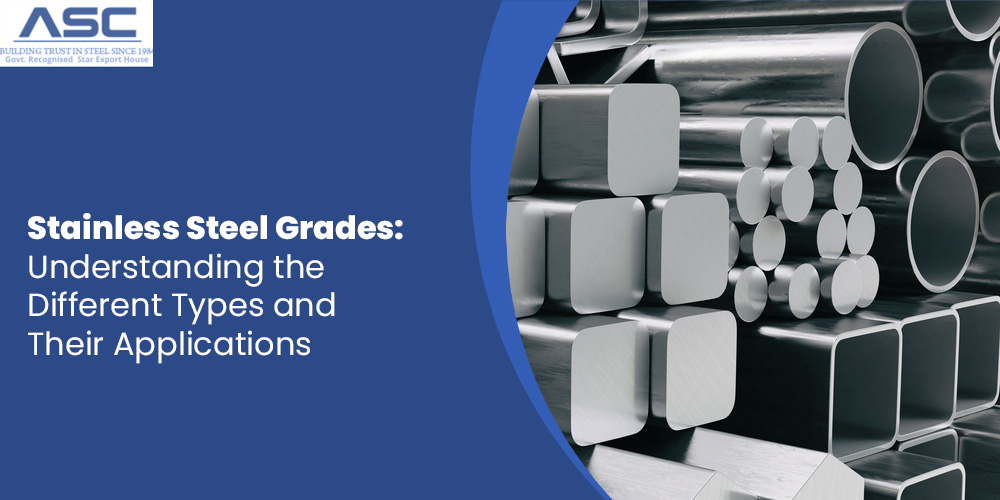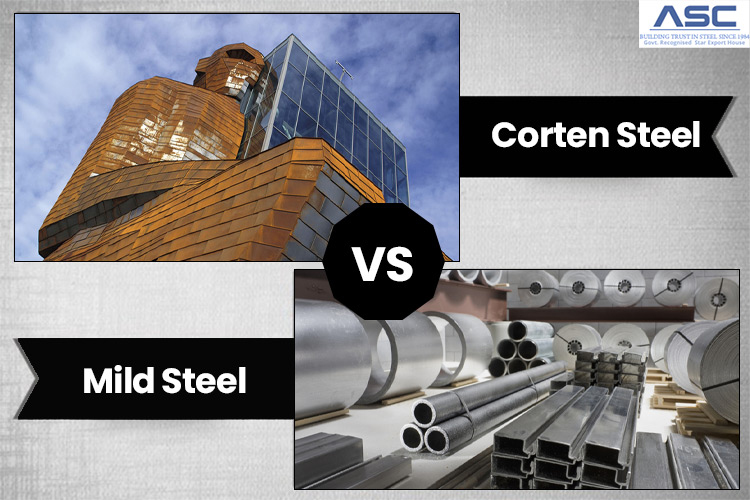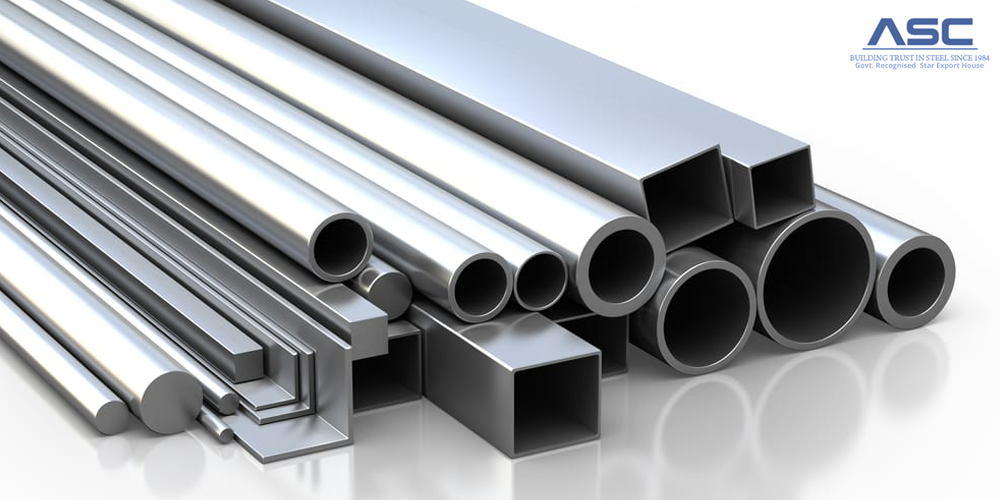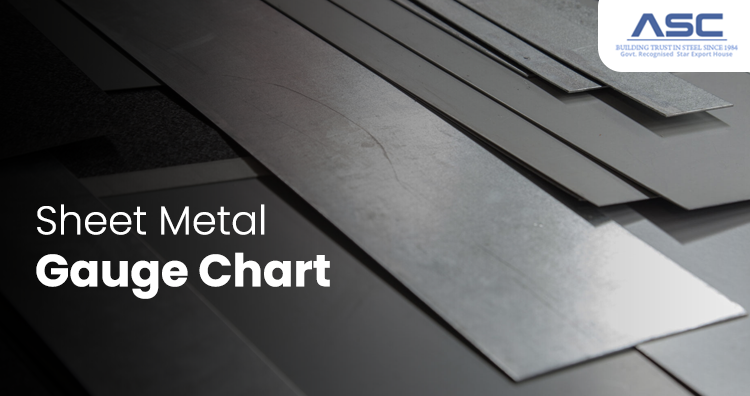Stainless Steel Grades: Understanding the Different Types and Their Applications
by AMC
Posted on August 03, 2023 at 02:37 PM

Stainless steel production continues to increase around the world year after year, thanks to its versatility,
durability, and affordability. However, stainless steel isn’t a single alloy. Various metals are marketed as
stainless steel today, deriving a large part of their corrosion resistance from chromium.
To find the best options when working with stainless steel, the first step is determining the proper alloy for
your product. Let’s take an active look at common types and considerations to demystify stainless steel,
understanding its diverse characteristics and making informed choices for your specific needs.
Stainless Steel Identifiers-understanding the Various Types
There’s two main labels you’ll find on most stainless steel alloys:
- Families
- Grades
Plenty, if you know what to look for…
Stainless Steel - Four Options With Unique Properties
Stainless steel, a remarkable material, can be categorized into four distinct families based on specific properties and the ratio of various metals in the alloy:
- Austenitic Stainless Steel: Known for its exceptional corrosion resistance, austenitic stainless steel contains high levels of chromium and nickel. It is non-magnetic and offers excellent formability and weldability, making it ideal for various applications, including kitchenware, piping, and architectural structures.
- Ferritic Stainless Steel: Featuring higher chromium content and low carbon, ferritic stainless steel boasts good corrosion resistance and magnetic properties. It finds application in automotive exhaust systems, decorative trims, and appliances.
- Duplex Stainless Steel: Combining the best of both austenitic and ferritic stainless steels, duplex stainless steel offers higher strength and improved resistance to stress corrosion cracking. Its applications range from marine components to chemical processing equipment.
- Martensitic & Precipitation Hardening Stainless Steel: These stainless steels are characterized by their high strength and hardness, achieved through heat treatment processes. Martensitic stainless steel is commonly used in cutlery, while precipitation hardening stainless steel finds use in aerospace components.
While the family classification is significant, understanding the distinguishing factor between different types of stainless steel requires a closer look at their specific grade. Grades further refine the characteristics of stainless steel, ensuring that the right material is chosen for each unique application.
Stainless Steel Grades
Within the different stainless steel families, you'll encounter a wide range of Stainless Steel grades that
precisely describe specific properties of the alloy, such as toughness, magnetism, corrosion resistance, and
alloy composition.
In the past, older grades were identified using a three-digit code established by the Society of Automotive
Engineers (SAE). However, in North America, you may also come across grades using a six-character identifier
set by the American Society for Testing and Materials (ASTM). These identifiers are known as Unified Number
System (UNS) identifiers. A comprehensive list of common identifiers can be found here.
Notably, many UNS identifiers share the same first three numbers as their AISI (American Iron and Steel
Institute) equivalent. Understanding these grade designations is crucial in selecting the right stainless
steel for your specific application, ensuring optimal performance and compatibility with your project's
requirements.
But there’s also grading systems created by:
- British Standards (BS)
- International Organization for Standardization (ISO)
- Japanese Industrial Standards (JIS)
- European Standard (EN)
- German Standard (DIN)
- Chinese Standard (GB)
Due to the multitude of various standards and grading systems in the stainless steel industry, obtaining
comprehensive information about a given alloy's unique composition solely from its grade can be challenging.
For example, 304 stainless steel by the SAE standard might also be graded as:
- EN number: 1.4305
- EN name: X8CrNiN18-9
- UNS: S30400
- DIN: X5CrNi18-9, X5CrNi18-10, X5CrNi19-9
- BS: 304S 15, 304S 16, 304S 18, 304S 25, En58E
- JIS: SUS 304, SUS 304-CSP
To obtain a specific grade designation in the stainless steel industry, the alloy must meet strict
requirements defined by the organization responsible for maintaining the standard.
In the case of the common SAE standards, 304 stainless steel must contain:
- 18% to 20% Chromium
- 8% to 10.5% Nickel
- 0.08% Carbon
- 2% Manganese
- 0.75% Silicon
- 0.045% Phosphorus
- 0.03% Sulfur
- 0.1% Nitrogen
Characteristics of Common Stainless Steel Families and Grades
Stainless steel comes in a variety of grades, which can be categorized into five main types:
- Austenitic: The most common type, austenitic stainless steels contain nickel, manganese, nitrogen, and sometimes molybdenum, in addition to iron and chromium. These alloys cannot be hardened through heat treatments but can be work-hardened.
- Martensitic: These stainless steels have high carbon contents, up to 1%, enabling them to be hardened and tempered similar to carbon and low-alloy steels.
- Ferritic: Ferritic steels have high chromium contents and low carbon contents, usually less than 0.10%. They cannot be work-hardened like austenitic steels but offer magnetic properties, high corrosion resistance, and resistance to corrosion-induced cracking.
- Duplex: Duplex steels have a material structure that is half austenitic and half ferritic, giving them superior strength and corrosion resistance.
- Precipitation Hardening (PH): PH steels contain additional elements such as aluminum, copper, or niobium, and undergo heat treatments, which enhance their material strength. They are less prone to thermal distortion, making them suitable for parts with intricate designs or tight tolerances.
At Amardeep Steel, we offer a wide range of stainless steel products to suit every customer’s needs. Our stainless steel product offerings include:
300 Series Austenitic Stainless Steel
Our 300 series of stainless steel is primarily austenitic in nature, characterized by chromium levels ranging between 18–30% and nickel levels of 6% to 20%. Within this series, we offer the following grades:
303 Stainless Steel303 stainless steel is a unique grade known for its exceptional machinability, thanks to its sulfur and phosphorus content. This makes it a preferred choice for applications where machining is a crucial requirement. In the aerospace industry, 303 stainless steel finds extensive use in manufacturing fittings, gears, bolts, and nuts.
304 / 304L Stainless Steel304 stainless steel is the most widely used austenitic stainless steel grade, known for its excellent
corrosion resistance, durability, and versatility. It finds applications in various industries, including
automotive, food and beverage, nuclear, and shipping, among others. The 304 grade's high corrosion resistance
makes it suitable for a wide range of environments, making it a popular choice for diverse applications.
On the other hand, 304L is a variation of 304 stainless steel with a lower carbon content. This reduced carbon
content enhances its weldability, making it ideal for welding applications. The lower carbon content helps
prevent sensitization and intergranular corrosion during welding, ensuring the integrity of welded
joints.
Both 304 and 304L stainless steel grades offer superior resistance to various corrosive substances and
maintain their strength and properties over a wide range of temperatures. Their versatility and robustness
make them go-to materials in industries that require high-quality and long-lasting stainless steel components.
Compared to 304, 316 stainless steel is less commonly used but offers distinct advantages in specific
applications. The alloy contains higher levels of molybdenum and nickel, which enhances its corrosion
resistance, especially against chlorides like salt and seawater. This makes it ideal for environments where
exposure to aggressive chemicals or marine conditions is a concern.
Additionally, 316 stainless steel is available in a low carbon variation known as 316L. The reduced carbon
content in 316L minimizes the risk of sensitization and intergranular corrosion during welding, preserving the
material's corrosion resistance in welded structures.
Due to its exceptional corrosion resistance, 316 stainless steel finds applications in nuclear plants and
marine environments, where the material's ability to withstand harsh conditions is vital.
On the other hand, 316L stainless steel is often preferred in the pharmaceutical and chemical industries,
where its high corrosion resistance and weldability are significant advantages.
Both 321 and 321H stainless steel grades contain titanium as an essential alloying element. The inclusion of
titanium imparts stabilization properties to these grades, which prevent sensitization and intergranular
corrosion during welding and high-temperature exposure.
The primary distinction between 321 and 321H lies in their carbon content. 321H contains a higher carbon
content compared to 321, providing it with greater temperature resistance. This elevated carbon level enhances
its ability to withstand higher temperatures without compromising its structural integrity.
Both 321 and 321H stainless steel grades find extensive use in chemical processing and oil and gas refineries.
Their exceptional high-temperature strength, corrosion resistance, and weldability make them suitable for
various critical applications in harsh environments.
Both 347 and 347H stainless steel grades contain a higher concentration of niobium and tantalum compared to
other stainless steel alloys. This niobium and tantalum addition provides enhanced stabilization properties,
making them highly suitable for welding applications.
The increased levels of niobium and tantalum in these grades prevent sensitization and intergranular corrosion
during welding and high-temperature exposure, ensuring the integrity of welded joints.
Due to their excellent weldability and resistance to sensitization, 347 and 347H stainless steel grades are
commonly used in airplane and automobile components, where welding is a critical part of the manufacturing
process. They are also frequently employed in chemical storage tanks, which require corrosion resistance and
structural reliability.
400 Series Martensitic Stainless Steel
Our 400 series of stainless steel is martensitic in nature, characterized by chromium levels ranging between 11–17%. Within this series, we distribute the following grades:
410 Stainless Steel:410 stainless steel is known for its durability and high resistance to wear, making it an excellent choice
for applications requiring robust and long-lasting materials. However, it is important to note that 410
stainless steel is more susceptible to chemical corrosion and oxidation compared to other stainless steel
grades with higher chromium content.
Despite its limited corrosion resistance, 410 stainless steel finds widespread use in various industries due
to its exceptional wear resistance. Common applications include automotive parts, where strength and wear
resistance are crucial for components like bearings and gears.
The medical industry also relies on 410 stainless steel for manufacturing medical products that require
strength and corrosion resistance, such as surgical instruments and medical implants.
Additionally, 410 stainless steel is employed in nozzles, pipelines, and valves where wear resistance and
durability are essential, especially in environments with high pressures and abrasive media.
416 stainless steel is a free-machining grade that contains sulfur, which significantly enhances its
machinability. This unique property makes 416 stainless steel an excellent choice for applications where ease
of machining is essential.
Due to its exceptional machinability, 416 stainless steel finds widespread use in various products, including
valves, pumps, studs, gears, and washing machine components.
440C stainless steel is renowned for its exceptional hardness and wear resistance, primarily due to its high
carbon content. It is considered one of the hardest stainless steel grades available. However, it is important
to note that 440C is only moderately corrosion resistant compared to other stainless steel alloys with higher
chromium content.
The remarkable hardness and wear resistance of 440C stainless steel make it an ideal material for various
applications that require materials to retain their shape under pressure and in abrasive environments.
Common uses of 440C stainless steel include knives, where the material's hardness allows for long-lasting
sharpness and edge retention. Surgical implements also benefit from 440C's wear resistance and shape
retention, ensuring consistent performance during delicate medical procedures.
Nozzles, due to their exposure to high pressures and abrasive media, benefit from the hardness and wear
resistance of 440C stainless steel, ensuring longevity and efficiency in critical industrial processes.
Duplex Stainless Steel
1.4307 Stainless Steel:1.4307 stainless steel, also known as AISI 304L, features low carbon content, making it less machinable than regular steels. Despite this, it finds diverse applications in various industries due to its wide range of desirable properties.
1.4404 Stainless Steel:1.4404 stainless steel, or AISI 316L, boasts high formability and exceptional corrosion resistance. Its resistance to acids is notably high as well, making it a popular choice in applications where exposure to corrosive environments is a concern.
1.4362 Stainless Steel:1.4362 stainless steel is a chromium-nickel duplex stainless steel with excellent resistance to localized corrosion. It also demonstrates resistance to stress corrosion cracking and exhibits high mechanical strength, making it suitable for demanding applications.
S31803 Stainless Steel:S31803 is a potential duplex steel with a 50:50 austenite-ferrite microstructure. It offers remarkable ductility, mechanical strength, and yield strength. Additionally, S31803 provides moderate to increased resistance to corrosion, making it an attractive material in various industries.
S32205 Stainless Steel:S32205 is a nitrogen-enhanced duplex stainless steel renowned for its high strength and excellent corrosion resistance. Its robust properties make it suitable for demanding applications where both strength and corrosion resistance are critical factors.
Precipitation Hardening Stainless Steel
Precipitation hardened stainless steels are highly valued for their excellent strength-to-weight ratio. They can be heat hardened like martensitic stainless steel while offering corrosion resistance comparable to austenitic stainless steel.
13-8 Stainless Steel:13-8 stainless steel is a low carbon alloy with high tensile strength and excellent corrosion resistance. It is commonly used in airplane components and nuclear equipment, where its combination of strength and corrosion resistance is vital.
15-5 Stainless Steel:15-5 stainless steel boasts exceptional corrosion resistance and durability. This makes it a preferred choice in industries such as aerospace, chemical, food processing, and general metalworking, where materials need to withstand harsh environments and corrosive substances.
17-4 / 17-4PH Stainless Steel:17-4PH stainless steel contains higher levels of chromium and copper, resulting in exceptional strength and corrosion resistance. It finds applications in demanding industries like offshore oil and gas and nuclear waste processing. Additionally, it is used in airplane and automotive components where durability and performance are crucial.
17-4 Stainless Steel:17-4 stainless steel is similar to 17-4PH but undergoes a single heat treatment process during manufacture, making it softer. However, it still finds use in similar applications, where its combination of strength and corrosion resistance meets the required specifications.
Stainless Steel for Your Business Needs
Stainless steel is an ideal choice for fulfilling your business needs due to its numerous advantageous qualities, including:
- Corrosion resistance
- Fire and heat resistance
- Impact resistance
- Strength-to-weight ratio
- Manufacturability
- Cleanability
Due to these outstanding qualities, stainless steel is widely used in various industries, including
construction, transportation, medical, food processing, and more. Its reliability, durability, and versatility
make it a valuable material for fulfilling diverse business needs.
At Amardeep Steel, we are committed to producing the best quality stainless steel for all industries. If you
need stainless steel for your next project, contact us or request a quote today.

304 vs 316 Stainless Steel
Stainless steel is a popular material in various industries because of its corrosion resistance, strength, and durability. Two of the most commonly used grades of stainless steel are 304 and 316.

